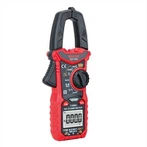How oscilloscope probes measure physical quantities such as time, frequency, and voltage values
You need to disassemble the oscilloscope probe first to see what's inside. The section connecting the oscilloscope is a BNC interface. If you do not use the BNC connector but directly use two wires to introduce the signal into the oscilloscope, you will notice that the signal is distorted, a square wave goes in, and a sawtooth wave is displayed! Why is this?
Oscilloscopes generally have higher input impedance to reduce the impact on the circuit under test. So you will see a 1M ohm resistor or similar circuit behind the probe BNC connector. This has advantages and disadvantages. A small external capacitor value will also form a filter at the input, thus distorting the measured waveform. How to solve this problem depends on how the probe is handled!
Generally, oscilloscope probes use a parallel adjustable capacitor to offset the influence of this part of the cable. Some compensation capacitors allow us to adjust ourselves and choose the best effect. There will be a square wave source on the oscilloscope. We hook the probe on the signal source and adjust the capacitor so that the square wave displayed on the screen becomes the most standard "square wave". Excessive capacitance will cause the probe to form a low-pass filter, and conversely, it will become a high-pass filter. So it needs to be adjusted carefully.
The square wave measured by the unadjusted probe
There is usually an attenuator on the probe to attenuate the signal under test. The multiple is generally 10 times. A 1V signal goes in and 100mV is displayed. Some oscilloscopes can automatically identify the status of the probe and display the correct value.
The probe uses the high impedance characteristic to ensure that the circuit is not interfered by the measurement part, but sometimes we need to use low impedance testing methods to measure certain circuits. For example, for a RF output circuit with 50 ohm impedance, for a machine with 50 ohm impedance measurement function, this is just a matter of pressing a button; but for an ordinary oscilloscope, the probe is not suitable for measurement at this time. You need to use a BNC tee with a 50 ohm end resistor to match it, and connect the other end directly to the 50 ohm output.






